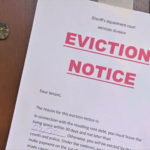A reference of North Dakota Eviction Laws, and steps of the North Dakota eviction process for landlords and renters, updated 2021.
- What are the reasons for eviction under North Dakota eviction laws?
- Non-payment of rent (N.D. Cent. Code §47-32-01)
- Violation of a material lease term (N.D. Cent. Code §47-32-01)
- Wrongful possession of property or force of threat (N.D. Cent. Code §47-32-01)
- The tenant remains in possession of the rental property after the lease term without the landlord’s permission (N.D. Cent. Code §47-32-01)
- What notice do North Dakota eviction laws require that landlords provide tenants before starting the eviction process?
- For evictions based on non-payment of rent, the landlord must provide a 3-day notice. (N.D. Cent. Code §47-32-01).
- For evictions based on a violation of a material lease term, the landlord must provide a 3-day notice. (N.D. Cent. Code §47-32-01).
- For evictions based on wrongful possession of the property or the force of threat, no notice is required. (N.D. Cent. Code §47-32-01)
- Do North Dakota eviction laws allow landlords to use “self-help eviction” methods, such as locking a tenant out of the rental unit or shutting off the utilities?
- No. North Dakota law prohibits self-help measures and a tenant can recover triple their damages if a landlord takes such action. (N.D. Cent. Code § 32-03-29).
North Dakota Eviction Process: Step-by-Step
The eviction process in North Dakota involves the following steps:
- The landlord serves the eviction notice. The landlord must serve an eviction notice on the tenant that has sufficient information about why the tenant is being evicted and what they can do to avoid eviction, if possible.
- The landlord files an eviction lawsuit. The tenant can respond to the notice by paying the late rent, curing the violation, or moving out of the property. If the tenant fails to do any of these, the landlord can begin the eviction process in North Dakota by filing the following documents:
- Eviction complaint – This document sets out the reasons for the eviction and asks the court for the applicable relief.
- Eviction summons – This document notifies the tenant that legal action is being taken against them. The summons states the hearing date.
- Affidavit of identification – This document sets out the personal information for the landlord and the tenant and indicates whether the tenant is in the military.
- Statement of costs & disbursements – This document states the damages the landlord has incurred and wants the tenant to pay for.
The landlord pays a filing fee and is responsible for serving the tenant with the documents.
- The parties attend the court hearing. The parties attend the court hearing and present their case. The court rules in one of the parties’ favor.
4. The landlord requests a writ of possession. If the tenant does not move out after a judgment is made against them, the landlord can request a writ of possession. This gives the sheriff the legal right to forcibly remove the tenant from the rental property.







